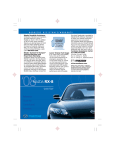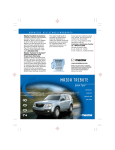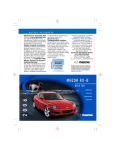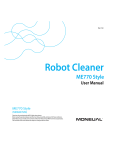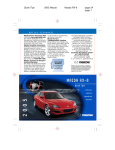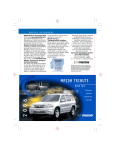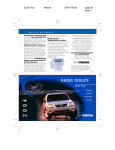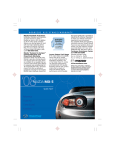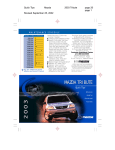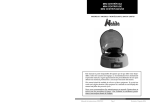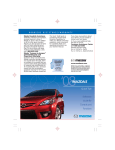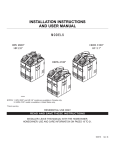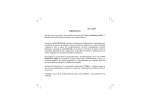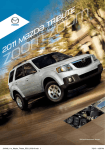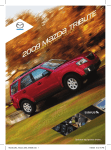Download Mazda Tribute HEV Quick Tips
Transcript
ROADSIDE ASSISTANCE/WARRANTY Mazda Roadside Assistance Exhilaration, liberation and inspiration, are great reasons to drive a Mazda car, truck or SUV. In addition to all the other great standard features, you also get peace of mind with our basic warranty period Emergency Roadside Assistance Plan, it’s just a phone call away, 24 hours a day, 365 days a year, call 1-800-866-1998. Mazda ‘’bumper-to-bumper” Limited Warranty and Powertrain Warranty Engineers design and build every Mazda to give you driving pleasure now and far down the road. We’re so confident in our quality that we cover the entire vehicle against defects in materials and workmanship for 36 months/36,000 miles, whichever comes first, plus we provide a powertrain warranty for 60 months/ 60,000 miles, whichever comes first. This Quick Tips® guide is provided by Mazda North American Operations to make your Mazda ownership experience more convenient. For complete details and operating instructions, see your Owner’s Manual. Unleaded Gasoline 87-octane minimum 15-gallon/ 57-liter tank 2.3L I4 If you have any questions about your vehicle, you are invited to contact your local dealer. Or if you need additional help, feel free to call our Customer Assistance Center at 1-800-222-5500 Monday through Friday, 8 a.m.- 4:45 p.m., Pacific 9 a.m.- 5:45 p.m., Eastern/Central www.mazdausa.com ©2007 Calcar, Quick Tips® is a trademark of Calcar, made in USA 3/07 3.193M DOT Mazda North American Operations reserves the right to change product specifications at any time without incurring obligations. 9999-95-014C-08HQT NB[EB USJCVUF IZCSJE USJCVUF!IZCSJE Rvjdl!Ujqt© Sfgfsfodf! Hvjef!gps! 3119 Dpouspmt!boe! Gvodujpot DRIVER’S VIEW 1 29 2 3 4 5 27 6 7 8 9 E 2 1 3 x1000r/min F CHARGE 10 11 4 12 13 4 14 15 60 40 80 5 20 0 2 1 ASSIST 4 0 6 2 1 0 4 7 453.2 2081.4 100 80 120 60 140 0 200 40 160 100 180 20 TRIP A 120 0 mph 25 24 23 22 21 20 19 26 28 17 16 18 19 11 1. Power window switches, see Mirrors/Windows 2. Power door locks, see Locks 3. Dual power mirrors, see Mirrors/Windows 4. Air vents 5. Turn signals/headlight high beams/wiper/ washer lever, see Getting Started Instrument panel lighting Move thumbwheel up/down to brighten/dim. Move thumbwheel up/down past detent to turn interior lights on/off. 7. Cruise control, see Getting Started 8. 9. 10. 11. 12. 13. 14. 6. 15. 16. 17. Hazard warning switch Push on/off. Horn/Air bag Ignition switch Auxiliary power point Passenger air bag off indicator, see Getting Started Display Clock and audio display. NAVI display*, see Owner’s Manual Audio system, see Audio Systems Climate control panel, see Climate Controls Heated seats*, see Climate Controls Auxiliary input jack Connect portable music device to in-vehicle audio system. 18. Storage 19. Cupholders 20. Gearshift lever (A/T), see Transaxle 21. Traction Control System, see Driving Tips 22. Tilt steering-wheel lever, see Getting Started 23. Hood release handle Pull to open partially. 24. Parking brake 25. Parking brake release lever 26. Lighting control knob, see Getting Started 27. Message center buttons*, see Getting Started 28. Power point (110 VAC) See Owner’s Manual 29. Jump start button Located behind access panel, see Owner’s Manual. *Denotes optional equipment Always check the Owner’s Manual for more operating information and safety features Driver’s View Getting Started GETTING STARTED Getting Started Tribute Quick Tips® are designed to quickly familiarize you with some important features of your Tribute Hybrid. The Driver’s View tab is your index to the Quick Tips®, locate the item you would like to learn more about and then turn to the listed tab. This Getting Started section contains important operating tips about your Tribute Hybrid. Items identified in blue text call out important information. Mazda Tribute Hybrid This section is a quick overview of your new Mazda Tribute Hybrid vehicle; you will need to get acquainted with various warnings, functions and additional maintenance that is directly related to your hybrid vehicle, it is also recommended that you review your Owner's Manual before operation, this will help ensure a safe and enjoyable driving experience for many years to come. Vehicle break-in period Vary vehicle speed for the first 1000 miles, this will allow moving parts to properly break-in, drive vehicle 500 miles before towing a trailer and never use break-in oils or additives. See Owner’s Manual for hybrid vehicle maintenance schedule and information. Hybrid vehicle operation Your hybrid vehicle will operate somewhat differently than a typical vehicle; this is due to the unique design of this type of vehicle. Starting vehicle: OTIS, One Touch Integrated Start, turn and release key; engine will start automatically, engine will not start in neutral position and depending on engine temperature and high voltage battery state of charge, engine may shut off shortly after starting; this is a normal condition, you do not need to restart vehicle, ready indicator located in instrument cluster illuminates when vehicle is running. Driving vehicle: When engine is at normal operating temperature you will experience transition from electric motor to hybrid operation (gasoline engine on) and vice versa, this is normal operation of this type of vehicle, a few conditions that will initiate gasoline engine startup; high voltage battery needs recharging, additional acceleration is required, outside air temperature is extremely hot or cold, starting up a hill or steep grade, remember that your hybrid vehicle gasoline engine may shut off when coming to a stop, this is a normal condition and will help save fuel. Tip: Your gasoline engine will not shut off at stops if climate control system is set to or modes (yellow indicators) or any position with the air conditioning on, see Climate Controls. Tips: Gasoline engine will start and stop automatically depending on various driving conditions. Hybrid vehicles do not operate like a conventional vehicle, what you may notice is various transitions between operating modes, but not the shift points that you are familiar with, this is a normal condition. Vehicle does not charge high voltage battery while in neutral, try not to let vehicle idle in neutral for long periods of time, this may discharge high voltage battery. Tip: After a substantial jolt to vehicle, it is possible that high voltage shutoff switch, see Cargo Area, and fuel pump shutoff switch, see Getting Started, may need to be reset. Unique operating sounds From time to time you will hear sounds that are unique to your hybrid vehicle, some of the sounds will include rear air conditioning system that is used to cool high voltage battery, pumping, venting or whining sounds, these are all normal sounds for a hybrid vehicle. Always check the Owner’s Manual for more operating information and safety features Getting Started Getting Started GETTING STARTED 1 PASSENGER AIRBAG OFF Passenger air bag deactivation indicator light Front passenger sensing system is designed to turn off passenger frontal air bag when a low weight is detected, a person of adult size that is sitting properly in the passenger front seat will enable passenger frontal air bag. The sensor also turns off the passenger front air bag and seatmounted side air bag* when the passenger seat is empty and seat belt is unbuckled to prevent 50 MILES TO E 0.0 MI 1 INFO SETUP RESET 2 3 4 Message center* Message Center (1) displays important vehicle information and warnings, ignition must be on to function. Info button (2): Trip odometer A or B, distance to empty, average fuel economy*, instantaneous fuel economy*, electric energy. Setup button (3): Reset to English, system check, oil life, units (English/Metric), autolamp delay*, autolock*, autounlock*, language. Reset button (4): Press to reset functions in INFO and SETUP menu. To reset trip odometer: Press and release INFO button until TRIP A/B unnecessary replacement of air bag(s) after a collision, PASSENGER AIRBAG OFF indicator lamp is not illuminated in this case. The front passenger seat-mounted side air bag* will be deactivated if the sensor detects an empty seat; otherwise, the seat-mounted side air bag* will be enabled. PASSENGER AIRBAG OFF indicator (1) will be illuminated to remind you the passenger air bag is deactivated. See Owner’s Manual for complete details and warnings. WARNING: If PASSENGER AIRBAG OFF light goes on or off or stays off unexpectedly, please see Owner’s Manual for various ways this system may indicate a false reading. appears; press and hold RESET button, see Instrument Cluster. Warnings include driver door ajar, passenger door ajar, rear left door ajar, rear right door ajar, stop safely now, high engine temperature, high motor temperature, park brake engaged. For complete warnings and details, see Owner's Manual. Fuel pump shutoff Disables fuel pump after a substantial jolt; located in front passenger’s footwell, behind flip-up cover, by kick panel access cover. To reset: Press down top of exposed red reset button (5). WARNING: Do not reset shutoff switch if you see or smell fuel. 5 Tire Pressure Monitoring System (TPMS) Warning light illuminates for a few seconds after ignition is on. If tire pressure is too low in one or more tires, warning light will illuminate. Flashing warning light indicates possible malfunction; dealer inspection required. 6 Gas cap Tip: When fueling vehicle, use gas cap clip (6) to hold cap away from vehicle. After filling vehicle with gasoline, fully reinstall gas cap by turning clockwise until a clicking sound is heard, if gas cap is not fully installed, Check Engine light and/or Check Fuel Cap indicator light may come on. For more information on Check Engine light, see Owner’s Manual. *Denotes optional equipment Always check the Owner’s Manual for more operating information and safety features Getting Started Getting Started GETTING STARTED A Lighting control knob = Lights off = Tail, parking and dashboard lights on: Rotate knob to first notch = Tail, parking, dashboard and headlights on: Rotate knob to second notch A = Autolamp control*: With ignition switch in ON position; headlights and exterior lights automatically turn ON/OFF depending on surrounding darkness/lightness 4 2 3 1 RESUME SET + SET – OFF ON = Foglamp control: Pull headlamp control knob towards you while in , or A position Tip: Exterior lights turn on automatically with ignition on, headlamp control in Autolamp position and windshield wipers activated for a fixed period of time. 2 1 0 0 1 2 Turn signals/headlight high beams/wiper/washer lever High beams on/off: Push lever forward to detent/pull back. To flash high beams: Pull lever rearward and release. Ignition switch must be in ACC or ON position. To turn on wipers: Rotate knob (1) forward to increase; turn rearward to decrease speed. To activate washers: Push in end of knob (1); will also operate wipers. Rear wiper/washer 0 = OFF 1 = Intermittent: Rotate knob (2) to first notch 2 = Normal speed: Rotate knob (2) to second notch = Rear wash/wiper cycle: Rotate knob (2) to third notch, hold as desired Tip: Courtesy wipe feature will give one extra wipe a few seconds after wipers are turned off, this will help clear off any residual drops left from using the washer fluid. Cruise control Operates above 30 mph. Press ON (1). To set speed: Press and release SET+ (2) at desired speed; hold (2) to accelerate. To decelerate: Press and hold SET – (3), release at desired speed; or tap brake pedal, press and release (2) at desired speed. Incremental deceleration: Press and release (3), each tap = minus 1 mph. Incremental acceleration: Press and release (2), each tap = plus 1 mph. To cancel: Tap brake pedal or press OFF button (1). Return to preset speed (after braking): Press and release RESUME button (4). Tilt steering-wheel release lever Pull lever (5) down to unlock column and pull up to lock column. WARNING: Do not adjust steering-wheel while driving because you may lose control of the vehicle. 5 *Denotes optional equipment Always check the Owner’s Manual for more operating information and safety features Getting Started Instrument Cluster INSTRUMENT CLUSTER 1 2 E 2 3 x1000r/min 3 F CHARGE 4 ASSIST 60 4 40 1 80 5 20 0 6 7 100 60 40 20 0 453.2 2081.4 TRIP A 80 120 140 160 100 180 200 120 0 mph 5 GAUGES 1. Tachometer 2. Fuel gauge 15-gallon/57-liter tank (2.3L I4 Hybrid Engine). 3. Battery gauge 4. Speedometer ASSIST indicates battery is 5. Odometer/trip odometer providing extra power to boost To reset trip odometer, see vehicle’s acceleration, CHARGE Message Center* in Getting indicates battery is storing extra Started section. energy when coasting or slowing. WARNING LIGHTS • Anti-lock Brake System (ABS) ABS malfunction, normal brakes only, dealer inspection required • Always fasten seat belts • Air bag readiness Front or side air bag malfunction, dealer inspection required • • • • • High beams on Cruise control on, see Getting Started • • • Door ajar Brake system Parking brake on/low brake fluid • • Check engine indicator Dealer inspection required if light remains on, see Owner’s Manual Engine oil pressure Stop car when safe and turn off engine; check oil level Charging system Charging system malfunction; dealer inspection required Throttle control/ powertrain Illuminates when a powertrain or throttle body fault has been detected; dealer inspection required if indicator remains on Tire Pressure Monitoring System (TPMS), see Getting Started ABS active/Traction control™ active* Flashes when ABS system is active; dealer inspection required if indicator remains on, see Driving Tips • • • • • • Low fuel Check fuel cap Fuel cap not securely tightened Anti-theft on Ready indicator light Indicates vehicle has successfully started, also indicates when vehicle is ready to drive Master vehicle electrical Hybrid component fault/failure that may cause vehicle to shutdown or not start Engine/motor electronic coolant temperature Indicates when operating temperature exceeds limit, when indicator is flashing or remains illuminated; shut engine off when safe, then let cool, see Owner’s Manual *Denotes optional equipment Always check the Owner’s Manual for more operating information and safety features Instrument Cluster Locks LOCKS 1 3 4 Key Operates ignition and all locks. Tip: OTIS, One Touch Integrated Start, turn key and release to start. SecuriLock™ passive anti-theft key Coded chip in key activates ignition. Tip: Use key number sticker on key to purchase a new key; store in safe place separate from vehicle. 1 2 Integrated Keyhead Transmitter (IKT) 1. Lock Press button; pressing again within 3 seconds causes doors to relock, horn to beep. 2. Unlock Press to unlock driver’s door; press again within 3 seconds to unlock other doors. 3. Panic alarm Press and hold 1 1/2 seconds to activate, horn sounds; press again to stop, or turn ignition to ON or START position, functions only with ignition in LOCK position. 4. Liftgate Press twice within 3 seconds to open liftgate glass. Tip: One step unlocking of all doors, liftgate and liftgate glass is available; to enable one step door unlocking, press and hold and for 4 seconds, parking lights flash twice; to reset to two step door unlocking, repeat procedure. Illuminated entry system Press unlock button on (IKT) Integrated Keyhead Transmitter, interior lights come on; lights turn off after 25 seconds or with ignition in ON position. Tip: Perimeter lamps illuminated entry feature turns on head, park and tail lamps when unlock button is pressed using (IKT) Integrated Keyhead Transmitter, lamps automatically turn off after 25 seconds or if IKT lock button is pressed. 4 L 3 2 Power door locks To unlock/lock all doors: Press / on driver’s door switch (1). To lock doors without key: With door open, press on driver’s door switch, exit vehicle, close doors. Smart unlocking system Prevents locking yourself out of vehicle with key in any ignition position; driver’s door will automatically unlock if locked using power lock control on driver’s door panel when door is open. Child-safety locks Located at the edge of rear doors. To activate: Insert key into slot (2) and rotate to . To cancel: Rotate key in opposite direction. WARNINGS: Since children may access either rear door, child-safety locks for both rear doors should be activated. Never leave a child in car with key in the vehicle. Liftgate Vehicle must be unlocked before opening liftgate or liftgate window. To open liftgate window: Press right side button (3) under rear license plate lamp shield. To open liftgate: Press and hold middle button (4), lift under rear license plate lamp shield. Tip: See Owner’s Manual for load capacity limits of your hybrid vehicle. Always check the Owner’s Manual for more operating information and safety features Locks Mirrors/ Windows MIRRORS/WINDOWS 2 AU 4 1 3 Dual power mirrors To adjust left/right mirror: Rotate control switch (1) left/right, tilt in direction of desired mirror movement. Tip: To lock mirrors in place, rotate control switch to center position. 4 2 1 5 2 1 1. Map/reading light switches To turn on/off: Press switch. Tip: Map light switches located on dome lamp on vehicles without moon roof. 2. Map/reading light Illuminates whenever any door is opened. 3. Dome lamp OFF = light always off DOOR = light on when door open ON = light always on *Denotes optional equipment TO Power windows Operate with ignition in ON position. All windows may be controlled from driver’s door; each passenger door has a separate switch. Driver’s window One-touch down: Press rear of switch (2) firmly and release, window goes down all the way; press briefly to stop; press and hold for normal operation; press and hold front of switch to close. OFF DOO R ON 3 4. Moon roof switch* To open: Press and hold rear of switch. To close: Press and hold front of switch. To tilt (panel closed): Press and hold front/rear of switch to open/close. One-touch express opening: Press and release rear of switch, to stop at any time; press switch again. Passenger window switches Press rear/front of switches (3) to open/close. Power window lockout switch Press right side of switch (4), only driver’s window operates; press left side of switch (4) and all windows function again. Tip: Power windows and moon roof can be operated for up to 10 minutes after ignition key is turned off and with doors closed, opening door will completely cancel this function. 3 2 1 2 1 5. Sunglasses storage compartment* To open: Press button, then pull to full open position. 6 6. Cargo lamp ON = light always on OFF = light always off DOOR = light on when door open Always check the Owner’s Manual for more operating information and safety features Interior Lights Climate Controls CLIMATE CONTROLS 1. AUTO/Driver temperature Press for automatic climate control operation. Driver temperature selection Cooler/warmer = rotate knob counterclockwise/clockwise Tip: Selecting AUTO will automatically determine fan speed, airflow distribution, A/C and outside/recirculated air setting. 2. Air flow selections 1 2 3 2 AUTO 4 PASS TEMP R A/C = air to dash ECON = air to dash and floor = air to floor 9 5 8 7 6 5 = air to floor and windshield = defrost, air to windshield Tip: Your gasoline engine will not shut off at stops if climate control system is set to or modes (yellow indicators) or any position with the air conditioning on. 3. Power/Fan speed Press to activate/deactivate climate control system, rotate knob to control air volume. 4. Passenger temperature selection Cooler/warmer = rotate knob counterclockwise/clockwise 5. Heated seats* Press ON/OFF. 6. Recirculated air Press to activate/deactivate. WARNING: Do not use recirculated air mode in cold weather, windows may fog and hamper vision. 7. ECON Press to activate/deactivate economy air conditioning mode. 8. A/C Air conditioning ON/OFF. 9. Rear defrost Press to activate/deactivate. Tip: Both outside mirrors are heated* automatically to help remove ice, mist and fog when rear window defrost is activated. Control positions for maximum defrost Press button; fan to maximum, temperature to maximum hot. Tips: To help prevent windshield fogging in humid weather, select before starting engine. To prevent moisture buildup, never drive with system off. Objects placed under the front seats may interfere with air flow to the rear. *Denotes optional equipment Always check the Owner’s Manual for more operating information and safety features Climate Controls Audio Systems AM/FM STEREO/CD/CD CHANGER 1. Power/Volume LOAD 5 Press to turn on/off; rotate to 6 1 2 3 4 5 increase/decrease volume. DIRECT 7 8 9 0 2. SHUFFLE 4 3 Press to select SHUFFLE (2); SCAN VOL which plays random CD/MP3 SEEK/ tracks or random multi-discs. SHUFFLE TRACK 1 3. SCAN CAT/FOLD Radio: Press to briefly sample listenable stations. AM/FM CD SAT CD/MP3: Press to briefly sample all track on current disc or folder. 2 19 17 18 16 15 4. DIRECT 9. CLOCK** 16. Press to access desired radio To set: Press CLOCK (9), display 17. station, track or MP3 folder. will read SET TIME, use memory Radio: Press DIRECT (4), then presets to set hours and minutes. press desired radio station 10. SOUND 18. using memory presets. Press (10) repeatedly to cycle CD: Press DIRECT (4); DIRECT through BASS/TREBLE/BALANCE/ TRACK MODE SELECT TRACK FADE/SPEED COMPENSATION will be displayed; enter desired VOLUME/ALL SEATS, press track number, system will SEEK/TRACK (18) to begin playing track. adjust settings. 5. 6. 7. 8. MP3 folder: Press DIRECT (4) and desired folder number, system will advance to selected folder. LOAD Press to load one disc or auto load up to six discs. CD slot EJECT Single CD: Press to eject disc. CD6 system: Press and select desired disc slot via memory preset button, display will read EJECTING #; when disc is ejected; display will read REMOVE CD #, remove disc quickly before system reloads disc. Memory presets To set: Tune to desired station, press and hold until sounds returns and PRESET # SAVED appears in display. EJECT 6 7 8 9 10 CLOCK SOUND TUNE MENU OK 11 TEXT AUX 14 13 12 CD AM/FM Press to select AM/FM1/FM2 frequency band. SEEK/TRACK Radio: Press / for previous/ next listenable station. CD/MP3: Press / for previous/next track. 19. CAT/FOLD 11. TUNE (Category/Folder) Rotate for higher frequency/ FM Radio mode: Select from lower frequency. various music categories, to 12. MENU change RDS categories, press Press (12) repeatedly to cycle MENU (12) until RDS ON is through AUTO PRESET ON/OFF/ displayed, press CAT. PRESS UP RDS ON/OFF/COMPRESSION, OR DOWN TO CHANGE RDS press SEEK/TRACK (18) CATEGORY will appear in to adjust settings. display, press SEEK/TRACK 13. TEXT to scroll through categories, To view additional display text; when desired category appears; Press TEXT (13), then press press SEEK/TRACK (18) to SEEK/TRACK (18). find next station playing desired 14. AUX selection or press SCAN (3) to Press to access AUX mode, sample all station playing. AUX mode can be used with external music players. MP3: Press FOLD (19) and 15. SAT (Satellite Radio)* press SEEK/TRACK to Press SAT (15) to access SAT1, access next/previous folder. SAT2 and SAT3 modes. Satellite radio is available only *Denotes optional equipment in the continental United States **See Navigation Owner’s Manual with a valid SIRIUS subscription, for clock setting procedure if equipped with Navigation System see Owner's Manual. Always check the Owner’s Manual for more operating information and safety features Audio Systems Seats SEATS Shoulder belt height adjustment 1 1 To raise/lower belt: Squeeze and hold release buttons (1) and slide up/down. WARNING: Make sure adjuster locks in one of its positions. Beltminder Intermittently sounds chime and illuminates seat belt warning lamp when driver’s seat belt is unbuckled and occupied. Manual controls 1. Fore/aft adjustment Raise lever and hold, slide seat, release lever. 2. Seatback angle Pull lever up to adjust seatback angle, release lever at desired angle. WARNINGS: Do not adjust seats while driving. Seat belts must always be worn when vehicle is in motion. Air bags are supplemental and do not replace seat belt usage. Always wear your seat belt and properly secure children 12 and under in the rear seat. Even with a deactivation system, never place rear-facing infant-safety seat in front of any air bag, an infant is in serious danger of being injured or killed. If you must install a forwardfacing child-safety seat in the front seating position, move vehicle seat as far back as possible. 4 8 3 2 1 5 6 7 Child-safety seat To install in rear outboard seats: Use dual locking mode retractor seat belts; see Owner’s Manual for proper installation and child seat tether and LATCH system instructions. WARNING: Use age appropriate child restraints, see Owner’s Manual and state or province laws. 3. Manual lumbar adjustment* Rotate clockwise/counterclockwise to increase/decrease firmness. 4. Head restraint To raise/lower: Pull up/hold release button (8) and push down. Power driver’s seat* 5. Raise/lower front of seat Pull/push front of switch up/down. 6. Fore/aft adjustment Slide entire switch horizontally. Raise/lower seat cushion Pull/push entire switch vertically. 7. Raise/lower rear of seat Pull/push back of switch up/down. WARNING: Never ride in a moving vehicle with any seat in a reclined position because you will not get the full protection from seat belts. Seat belt emergency locking mode Belts lock only on hard acceleration, braking, cornering or impacts of about 5 mph or more. Automatic locking mode (all seat belts except driver’s seat belt) Must be used when installing child-safety seat. To activate: Pull webbing fully out of retractor, allow belt to retract until click is heard; belt will only tighten. To disengage: Unbuckle belt and allow webbing to retract fully. Passenger air bag sensing system, see Getting Started *Denotes optional equipment Always check the Owner’s Manual for more operating information and safety features Seats Rear Seats REAR SEATS 2 2 1 1 3 1 4 2 Tip: See Owner's Manual for load capacity limits of your hybrid vehicle. Folding second-row seats Remove rear seat head restraint and store under front seat; pull seat release strap (1); flip seat cushion forward; pull seatback release lever (2) and lower seatback slowly to flat position. Returning rear seats to upright position Pull seatback upward until fully locked into upright position; move seat cushion back into locked normal seating position; make sure RED seat unlatched indicator (3) is not visible, reinstall head restraints to original position. 3 2. Jack and tools 1. Spare tire Stored behind right Stored underneath the vehicle. rear access panel. Removing spare tire: Insert High voltage lug wrench via access hole (4), shutoff switch turn lug wrench handle Located behind right counterclockwise to lower rear access panel. spare tire. Disables high voltage system To change flat tire: Follow after a substantial jolt. instructions in Owner’s Manual. To reset, see Owner’s Manual. WARNING: Do not exceed WARNING: Do not reset 50 mph with temporary spare. shutoff switch if you see or smell fuel. Tip: For instructions and restrictions on use 3. High voltage of temporary spare tire, battery air filter see Owner’s Manual. To change filter: Remove access cover; push tabs on each side of filter cover while pulling gently to remove filter cover, install new filter (arrows indicate top) and cover; re-install access panel. Always check the Owner’s Manual for more operating information and safety features Cargo Area Transaxle TRANSAXLE P R N D L electronically-controlled Continuously Variable Transaxle (eCVT) Gearshift must be in Park or Neutral to start engine; it must be in Park to remove ignition key. 10 8 P = Park To move gearshift from Park: You must press firmly on the brake pedal and the ignition must be in the ON position. R = Reverse Never engage Reverse when vehicle is moving. N = Neutral No gear is engaged; vehicle can roll freely, even on a slight incline, unless the brakes are applied. D (Drive) For normal driving conditions, D position provides best fuel economy. L = Low Provides maximum engine braking but will reduce fuel economy. 2 7 4 Four wheel drive (4WD) system*† Your Tribute is equipped with a 4WD system that is always active and requires no driver input, Tribute’s intelligent 4WD system monitors vehicle conditions and will automatically adjust power distribution between front and rear wheels, the 4WD system is capable of highway, off-road and winter road conditions. During some extreme off-road events the 4WD system may go into heat protection mode (locked mode), this will help protect the system, to exit heat protection mode, stop vehicle and let it cool down with engine running. 4. 5. 6. 7. 8. Air filter Battery Hood latch Power distribution box Engine oil filler cap 5W-20 engine oil. 9. Engine oil dipstick Check with engine off and at normal temperature; oil level should be within crosshatched area of dipstick. 1 3 9 6 5 10. Motor/Electronics (M/E) 2.3L I4 Hybrid Engine coolant reservoir Check M/E coolant level 1. Windshield washer 3. Engine coolant reservoir when engine is cold, use reservoir Level should be at cold fill level same coolant for both engine Fill with windshield washer or within the cold fill range and M/E reservoir. fluid, not water. when cold. Tip: Check all fluids with 2. Brake fluid reservoir WARNING: Never remove vehicle parked on a level Fill to MAX mark with DOT 3 coolant reservoir cap surface and engine off fluid, check with cap on. while engine is running unless otherwise stated. or hot; remove only *Denotes optional equipment when system is cool. † See Owner’s Manual Always check the Owner’s Manual for more operating information and safety features Under Hood Driving Tips DRIVING TIPS Tire economy and tips Check pressure monthly when tires are cold, see Owner’s Manual for rotation schedule and chart. Tire pressure Decal on driver’s door latch pillar provides tire size and pressure information. Tire chains*† Tire chains can damage aluminum wheels; use on steel wheels only. Tips: Use only SAE class “S” chains, install only on front axles if vehicle is 2WD (with P235/70R16 tires) and on both axles if 4WD. Install as tightly as possible and retighten periodically. Never exceed 30 mph with tire chains. 5,000 miles A 10,000 miles AB 20,000 miles A CDEFG 30,000 miles AB 40,000 miles A CDEFG H 50,000 miles AB 60,000 miles A CDEFGH 70,000 miles AB 80,000 miles A CDEFG 90,000 miles AB 100,000 miles H A CDEFG I 110,000 miles AB 120,000 miles A CDEFGH 130,000 miles AB 140,000 miles A CDEFG 150,000 miles AB H J Anti-lock Braking System (ABS) ABS automatically reduces hydraulic pressure to any wheel on the verge of locking up. You may feel a slight pulsing of the brake pedal and hear a clicking noise; this tells you the ABS is functioning properly; increase pressure on pedal for maximum braking. Tips: Maintain constant pressure on the brake pedal. Do not pump the brakes. ABS self test A self-diagnostic test is performed when starting; you may feel some brake pedal pulsation and hear some noise, this is normal. ABS active/Traction control™ active* Enhances traction and safety by regulating engine torque. When TCS detects drive wheel slippage it lowers engine torque to prevent loss of traction. A. Change: Engine oil/replace filter Inspect: Tire inflation pressure and tire wear, rotate tires B. Inspect: High voltage battery A/C filter, replace if necessary C. Inspect: Brake pads, shoes, rotors, drums, brake lines/ hoses and parking brake D. Inspect: Engine and motor/ electronics cooling system and hoses E. Inspect: Steering linkage, suspension, half-shafts*, driveshaft and ball joints F. Inspect: Exhaust system/ heat shields G. Replace: High voltage battery A/C filter H. Replace: Engine air filter I. Inspect: Accessory drive belt Replace: Spark plugs, fuel filter, engine and motor/ electronics coolant J. Inspect: PCV valve, replace if necessary Replace: Engine and motor/ electronics coolant, accessory drive belt, rear axle lubricant (4WD only) Tip: For additional service details, see Owner’s Manual. WARNING: Never remove, cut or modify any orange cable, serious injury can occur from electrocution. * Denotes optional equipment † See Owner’s Manual Always check the Owner’s Manual for more operating information and safety features ROADSIDE ASSISTANCE/WARRANTY Mazda Roadside Assistance Exhilaration, liberation and inspiration, are great reasons to drive a Mazda car, truck or SUV. In addition to all the other great standard features, you also get peace of mind with our basic warranty period Emergency Roadside Assistance Plan, it’s just a phone call away, 24 hours a day, 365 days a year, call 1-800-866-1998. Mazda ‘’bumper-to-bumper” Limited Warranty and Powertrain Warranty Engineers design and build every Mazda to give you driving pleasure now and far down the road. We’re so confident in our quality that we cover the entire vehicle against defects in materials and workmanship for 36 months/36,000 miles, whichever comes first, plus we provide a powertrain warranty for 60 months/ 60,000 miles, whichever comes first. This Quick Tips® guide is provided by Mazda North American Operations to make your Mazda ownership experience more convenient. For complete details and operating instructions, see your Owner’s Manual. Unleaded Gasoline 87-octane minimum 15-gallon/ 57-liter tank 2.3L I4 If you have any questions about your vehicle, you are invited to contact your local dealer. Or if you need additional help, feel free to call our Customer Assistance Center at 1-800-222-5500 Monday through Friday, 8 a.m.- 4:45 p.m., Pacific 9 a.m.- 5:45 p.m., Eastern/Central www.mazdausa.com ©2007 Calcar, Quick Tips® is a trademark of Calcar, made in USA 3/07 3.193M DOT Mazda North American Operations reserves the right to change product specifications at any time without incurring obligations. 9999-95-014C-08HQT NB[EB USJCVUF IZCSJE USJCVUF!IZCSJE Rvjdl!Ujqt© Sfgfsfodf! Hvjef!gps! 3119 Dpouspmt!boe! Gvodujpot















